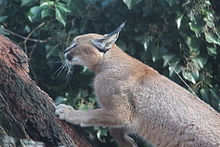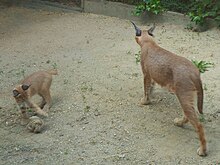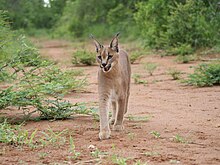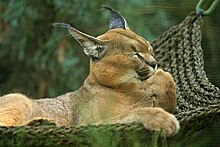Typically nocturnal (active at night), the caracal is highly secretive and difficult to observe. It is territorial, and lives mainly alone or in pairs. The caracal is a carnivore that typically preys upon small mammals, birds and rodents. It can leap higher than 3 m (9.8 ft) and catch birds in mid-air. It stalks its prey until it is within 5 m (16 ft) of it, after which it runs it down, the prey being killed by a bite to the throat or to the back of the neck. Breeding takes place throughout the year with both sexes becoming sexually mature by the time they are a year old. Gestation lasts between two and three months, resulting in a litter of one to six kittens. Juveniles leave their mothers at nine to ten months, though a few females stay back with their mothers. The average lifespan of the caracal in captivity is nearly 16 years.
The caracal inhabits forests, savannas, marshy lowlands, semi-deserts, deserts, and scrub forests. The caracal is classified as Least Concern by the IUCN. Its survival is threatened by habitat loss due to agricultural expansion and desertification; caracals are often persecuted for killing small livestock. Caracals have been tamed and used for hunting since the time of the ancient Egyptians until as recently as the 20th century.

Taxonomy and etymology
The caracal is placed in the family Felidae and subfamily Felinae. The species was first described by German naturalist Johann Christian Daniel von Schreber as Felis caracal in the journal Die Säugetiere in Abbildungen nach der Natur mit Beschreibungen in 1776. In 1843, British zoologist John Edward Gray placed the animal in the genus Caracal.[2] The name "caracal" is composed of two Turkish words: kara, meaning black, and kulak, meaning ear. The first recorded use of this name dates back to 1760.[3] Alternative names for the caracal include gazelle cat, red cat, rooikat, and red[citation needed] or Persian lynx.[4] The "lynx" of the Greeks and Romans was most probably the caracal[5] and the name "lynx" is sometimes still applied to it,[6] but the present-day lynx proper is a separate species.[5]
Earlier, the caracal was classified under the genera Felis[7] or Lynx.[4] However, a 2006 phylogenetic study showed that the caracal evolved nearly a million years before the lynx appeared.[8] The caracal is most closely related to the African golden cat (Profelis aurata, often considered a species of Caracal). These two species, together with the serval (Leptailurus serval), form one of the eight lineages of Felidae. The Caracal lineage came into existence 8.5 mya, and the ancestor of this lineage arrived in Africa 8.5–5.6 mya.[9][10] It diverged from the serval probably within the last five million years, around the boundary between the Pliocene and the Pleistocene.[11]
Eight subspecies are recognised:[2][12]
- North African caracal (C. c. algira) (Wagner, 1841) – Occurs in northern Africa (Algeria, Libya, Morocco, Tunisia)
- Common caracal (C. c. caracal) (Schreber, 1776) – Occurs in central and southern Africa (South Africa)
- Namibian caracal (C. c. damarensis) (Roberts, 1926) – Occurs in Namibia
- Transvaal caracal (C. c. limpopoensis) (Roberts, 1926) – Occurs in Botswana and northern South Africa
- Gabon caracal (C. c. lucani) (Rochebrune, 1885) – Occurs in northern Angola, Democratic Republic of the Congo, Gabon and Republic of the Congo
- Nubian caracal (C. c. nubica) (J. B. Fischer, 1829) – Occurs in central Africa (Cameroon, Ethiopia, South Sudan and Sudan)
- West African caracal (C. c. poecilotis) (Thomas and Hinton, 1921) – Occurs in western and central Africa (Senegal, Nigeria, Niger and western Sudan)
- Asiatic caracal (C. c. schmitzi) (Matschie, 1912) – Occurs in Asia (Afghanistan, western India, Iran, Iraq, Israel, southwestern Kazakhstan, Kuwait, Lebanon, Oman, Pakistan, Qatar, Russia, Syria, southern Turkey, Turkmenistan, United Arab Emirates, southwestern Uzbekistan)
|
|||||||||||||||||||||||||||||||||||||||||||||||||||||||||||||||||||||||||||||||||||||
Characteristics
A close facial view of a caracal. Note the tufted ears and the black and white facial markings.
The prominent facial features include the 4.5 centimetres (1.8 in) long black tufts on the ears, two black stripes from the forehead to the nose, the black outline of the mouth, and the white patches surrounding the eyes and the mouth.[15] The eyes appear to be narrowly open due to the lowered upper eyelid, probably an adaptation to shield the eyes from the sun's glare. The ear tufts may start drooping as the animal ages. The coat is uniformly reddish tan or sandy, though black caracals are also known. The underbelly and the insides of the legs are lighter, often with small reddish markings.[15] The fur, soft, short and dense, grows coarser in the summer. The ground hairs (the basal layer of hair covering the coat) are denser in winter than in summer. The length of the guard hairs (the hair extending above the ground hairs) can be up to 3 centimetres (1.2 in) long in winter, but shorten to 2 centimetres (0.8 in) in summer.[16] These features indicate the onset of moulting in the hot season, typically in October and November.[17] The hindlegs are longer than the forelegs, so that the body appears to be sloping downward from the rump.[14][15]
The caracal is often confused with the lynx, as both cats have tufted ears. However, a notable point of difference between the two is that the lynx is spotted and blotched, while the caracal shows no such markings on the coat.[15] The African golden cat has a similar build as the caracal's, but is darker and lacks the ear tufts. The sympatric serval can be told apart from the caracal by the former's lack of ear tufts, white spots behind the ears, spotted coat, longer legs, longer tail and smaller footprints.[16][18]
The skull of the caracal is high and rounded, featuring large auditory bullae, a well-developed supraoccipital crest normal to the sagittal crest, and a strong lower jaw. The caracal has a total of 30 teeth; the dental formula is 3.1.3.13.1.2.1. The deciduous dentition is 3.1.23.1.2. The striking canines are up to 2 centimetres (0.8 in) long, heavy and sharp; these are used to give the killing bite to the prey. The caracal lacks the second upper premolars, and the upper molars are diminutive.[17] The large paws, similar to those of the cheetah,[19] consist of four digits in the hindlegs and five in the forelegs.[16] The first digit of the foreleg remains above the ground and features the dewclaw. The claws, sharp and retractable (able to be drawn in), are larger but less curved in the hindlegs.[16]
Ecology and behaviour
Caracals are efficient climbers.
Diet and hunting
A caracal feeding
Its speed and agility make it an efficient hunter, able to take down prey two to three times its size.[1] The powerful hind legs allow it to leap more than 3 metres (10 ft) in the air to catch birds on the wing.[15][27][28] It can even twist and change its direction mid-air.[15] It is an adroit climber.[15] It stalks its prey until it is within 5 metres (16 ft), following which it can launch into a sprint. While large prey such as antelopes are killed by a throat bite, smaller prey are suffocated by a bite on the back of the neck.[15] Kills are consumed immediately, and less commonly dragged to cover. It will return to large kills if undisturbed.[16] It has been observed to begin feeding on antelope kills at the hind parts.[17] It may scavenge at times, though this has not been frequently observed.[21] It often has to compete with foxes, wolves, leopards and hyaena for prey.[19]
Reproduction
Caracal mother and kitten
Gestation lasts nearly two to three months, following which a litter consisting of one to six kittens is born. Births generally peak from October to February. Births take place in dense vegetation or deserted burrows of aardvark and porcupines. Kittens are born with their eyes and ears shut and the claws non-retractable (unable to be drawn inside); the coat resembles that of adults, but the abdomen is spotted. Eyes open by ten days, but it takes longer for the vision to become normal. The ears become erect and the claws become retractable by the third or the fourth week. Around the same time the kittens start roaming their birthplace, and start playing among themselves by the fifth or the sixth week. They begin taking solid food around the same time; they have to wait for nearly three months before they make their first kill. As the kittens start moving about by themselves, the mother starts shifting them everyday. All the milk teeth appear in 50 days, and permanent dentition is completed in 10 months. Juveniles begin dispersing at nine to ten months, though a few females stay back with their mothers. The average lifespan of the caracal in captivity is nearly 16 years.[15][19][29]
Distribution and habitat
Caracal inhabit dry areas with some cover.
Threats and conservation
A caracal in the San Diego Zoo
Interaction with human beings

Caracals appear to have been religiously significant to the ancient Egyptians. Caracals occur in paintings and as bronze figurines; their sculptures were believed to guard the tombs of pharaohs. Embalmed caracals have also been discovered.[30] The ear tufts have been elaborately depicted in some tombs, and referred to as umm risha't ("mother of feathers").
Chinese emperors would use caracals, as well as cheetah, as gifts.[31] In the 13th and the 14th centuries, the Yuan rulers bought numerous caracals, cheetah and tigers from the western parts of the empire and Muslim merchants in return for gold, silver, cash and silk. According to the Ming Shilu, the subsequent Ming dynasty (14th to 17th centuries) continued this practice. Until as recently as the 20th century, the caracal was used in hunts by Indian rulers to hunt small game, while the cheetah was used for larger game.[31] In those times, caracals would be exposed to a flock of pigeons and people would bet on which caracal would kill the largest number of pigeons. This probably gave rise to the expression "to put the cat among the pigeons".[28]
In the present day, caracals may be kept as pets. They can adapt well to domestic surroundings and are not generally aggressive toward domestic cats and dogs. However, they are typically declawed as their scratches might be dangerous. Caracals should be kept away from pet birds, as they may prey on them.[32] The coat of the caracal is used in making fur coats, while its skin does not have much economic significance.[19]






No comments:
Post a Comment
Note: Only a member of this blog may post a comment.